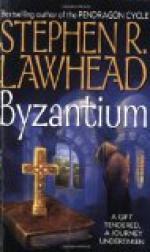|
This section contains 1,405 words (approx. 5 pages at 300 words per page) |

|
SOURCE: “‘Sailing to Byzantium’,” in Classical Journal, Vol. 41, No. 2, November, 1945, pp. 78-79.
In the following essay, Notopoulos investigates the sources for the imagery found in “Sailing to Byzantium.”
W. B. Yeats', “Sailing to Byzantium,” one of his best poems, is also a noteworthy Platonic lyric.1 The contrast in the poem between the “sensual music” and the “monuments of unageing intellect” is the mature expression of a Platonic mood, shaped and given impetus to expression by Yeats' interest in Plato and Plotinus, his friendship with Stephen MacKenna, and his study and admiration of MacKenna's great translation of Plotinus.2 In his desire to be gathered into the “artifice of eternity” and in his construction of a Platonic Reality, Yeats has chosen the imagery of Byzantium which held a powerful grip on his imagination:
Once out of nature I shall never take My bodily form from any natural thing, But such...
|
This section contains 1,405 words (approx. 5 pages at 300 words per page) |

|


